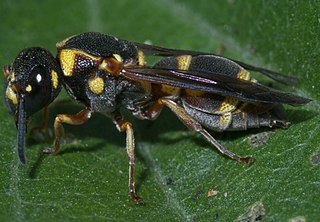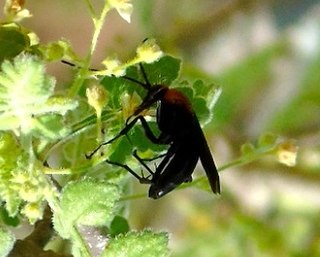
Wasps of the genus Sphex are cosmopolitan predators that sting and paralyze prey insects. Sphex is one of many genera in the old digger wasp family Sphecidae, though most apart from the Sphecinae have now been moved to the family Crabronidae. There are over 130 known Sphex species.

Polistes is a cosmopolitan genus of paper wasps and the only genus in the tribe Polistini. Vernacular names for the genus include umbrella wasps, coined by Walter Ebeling in 1975 to distinguish it from other types of paper wasp, in reference to the form of their nests, and umbrella paper wasps. Polistes is the single largest genus within the family Vespidae, with over 200 recognized species. Their innate preferences for nest-building sites leads them to commonly build nests on human habitation, where they can be very unwelcome; although generally not aggressive, they can be provoked into defending their nests. All species are predatory, and they may consume large numbers of caterpillars, in which respect they are generally considered beneficial.

Stenodynerus is a rather large genus of potter wasps whose distribution spans the Nearctic, Palearctic, Oriental and Neotropical regions. Most of its species lack a transverse carina on the first metasomal tergum. A pair of medial pits on the anterior face of the pronotum and the expansion of the tegulae put this genus close to genera as Parancistrocerus, Hypancistrocerus and Eustenancistrocerus.

Diaphorinae is a subfamily of flies in the family Dolichopodidae.

Mimumesa is a genus of wasps in the family Psenidae. The species are found in the Holarctic. 32 species are known to exist.
Paracyphononyx is a genus of spider wasps distributed in the tropics and warmer temperate regions; they differ from other pompilids in that they do not permanently disable the host spider but allow the spider to resume activity after the wasp has laid its egg on the spider while the wasp larva exists as koinobiont ectoparasitoid of the spider.

Psen is a genus of aphid wasps in the family Psenidae. There are at least 90 described species in Psen.
Epinysson is a genus of kleptoparasitic wasps in the family Bembicidae. There are more than 20 described species in Epinysson.

Hoplisoides is a genus of sand wasps in the family Bembicidae. There are at least 70 described species in Hoplisoides.
Pluto is a genus of aphid wasps in the family Psenidae. There are at least 50 described species in Pluto.

Lymeon is a genus of ichneumon wasps in the family Ichneumonidae. There are at least 80 described species in Lymeon.

Hyptia is a genus of ensign wasps in the family Evaniidae. There are at least 50 described species in Hyptia. Most Hyptia can be differentiated from other genera by heavily reduced venation of the forewings, wherein only one closed cell is present.

Melanopleurus is a genus of seed bugs in the family Lygaeidae. There are more than 20 described species in the genus Melanopleurus.

Stigmus is a genus of aphid wasps in the family Pemphredonidae. There are more than 20 described species in Stigmus.
Pseneo punctatus is a species of aphid wasp in the family Psenidae. It is found in Central America and North America.

Notocyphus is a genus of spider wasps, belonging to the family Pompilidae. They are the only genus in the monotypic subfamily Notocyphinae. These wasps are found in the Nearctic and the Neotropics.











